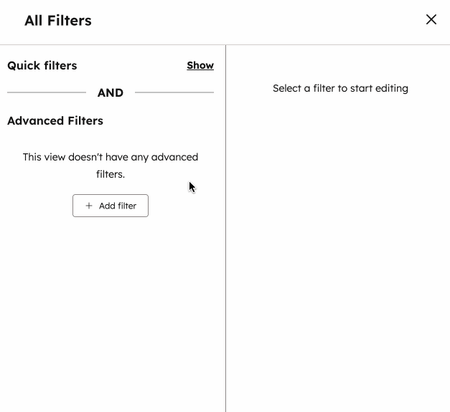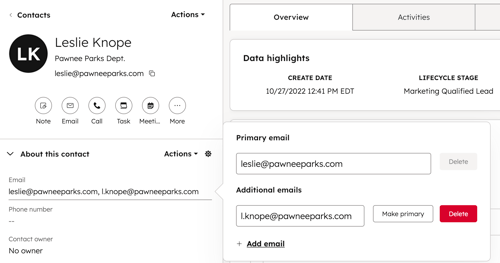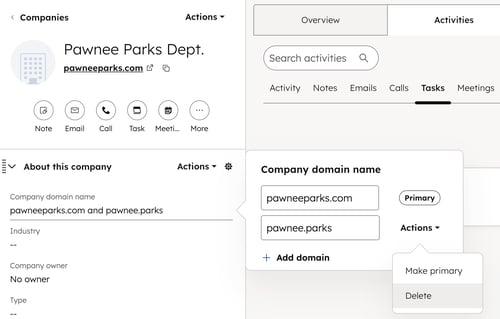- Knowledge Base
- CRM
- Records
- Merge records
Merge records
Last updated: December 11, 2025
Available with any of the following subscriptions, except where noted:
-
Additional subscriptions required for certain features
In your HubSpot account, you can merge two records of the same object into one record. For example, if two company records were created for HubSpot, you can merge them. This will result in one company record with activities and associations from both records.
Please note: your account may use personalized names for each object (e.g., account instead of company). This document refers to objects by their HubSpot default names.
Before you get started
When preparing to merging records, you should understand how your record data will be affected. The expected behavior for merging records differs based on which object’s records you’re merging. Learn more about what happens to your data for each type of merge.
It's also important to note that once you've merged two records, it is not possible to unmerge them. For contacts and companies, you can create a new record with the merged email addresses or domain names. For all objects, you can use the Merged [record] IDs property to view previously merged records.
Merge records
To merge records in your account:
- Navigate to your records:
- Contacts: In your HubSpot account, navigate to CRM > Contacts.
- Companies: In your HubSpot account, navigate to CRM > Companies.
- Deals: In your HubSpot account, navigate to CRM > Deals.
- Tickets: In your HubSpot account, navigate to CRM > Tickets.
- Appointments (if activated): In your HubSpot account, navigate to CRM > Appointments.
- Courses (if activated): In your HubSpot account, navigate to CRM > Courses.
- Listings (if activated): In your HubSpot account, navigate to CRM > Listings.
- Services (if activated): In your HubSpot account, navigate to CRM > Services.
- Custom objects: In your HubSpot account, navigate to CRM, then select the custom object.
- Click the name of the record that will be considered your primary record.
- In the left panel, click the Actions dropdown menu, then select Merge.

- In the dialog box, click the dropdown menu, then search for and select the record to merge into the primary record. This is considered your secondary record.
- To choose which property values are retained in the resulting record, click the values you want to keep. By default, the primary record's properties are selected since they are generally kept following a merge.
- To change which properties are displayed when comparing the records, click Set properties to review. Click Apply once you've selected the properties.
- Click Merge.

Please note: if you merge records while on a call, the call will be automatically disconnected.
You'll be notified that the merge is in progress. It can take up to 30 minutes for all the records’ activities to sync.
If your merge fails, it may be due to a merge limit. You cannot merge records if they've been included in a combined total of 250+ merges (e.g, Contact A and Contact B have been involved in 130 merges each). Once this limit is reached, you need to either create a new record or manually edit the record instead of merging. There are also certain scenarios where you will not be able to merge companies.
View records that have been merged
You can use the Merged [record] IDs properties to view which records were previously involved in a merge. You can access this property on an individual record, or filter all of your records based on if they have a value for the property.
To view the property on an individual record:
- Navigate to your records.
- Click the name of a record.
- In the left panel, click Actions, then click View all properties.
- In the search bar, enter Merged.
- If the record was involved in a merge, the Merged [record] IDs property will contain the Record ID values of all records previously merged into that record. Learn how to edit which properties appear in properties sections.

To view all records of a specific object that were involved in a merge:
- Navigate to your records.
- Above the table, click All filters.
- In the right panel, in the search bar, enter Merged, then select Merged [record] IDs.
- Select is known.

- Click the X in the top right to close the panel.
- The view will contain only records that have been included in a merge. For these records, the property will contain the Record ID values of all records previously merged into that record.
Learn more about filtering your records.
What happens when I merge records?
Subscription required
- A Sales or Service Hub Professional or Enterprise subscription is required for merges to impact playbooks.
- A Professional or Enterprise subscription is required for merges to impact workflow enrollment or Salesforce sync.
When you merge records, the following will occur by default:
- Record ID: a new unique Record ID is created for the resulting merged record. You can use the Merged [record] IDs property to search using the original Record ID value.
- Create date: the value for the oldest record is maintained.
- Property values: in general, the primary record's property values are prioritized, which means the merged record's values will reflect those from the primary record. Exceptions include Record ID, Create date, and certain contact properties and company properties. If desired, you can choose which property values to keep in the resulting merged record.
Please note: if the primary record does not have a value for a property (e.g., null, empty) the secondary record's value is used.
- Activities: all timeline activities of both records included in the merge will appear on the new record.
- Associations: all associated records of both records included in the merge will appear on the new record. For company associations with the Primary label, the primary company from the primary merge record is prioritized. The secondary record's primary association will still appear on the new record, but the Primary label will be removed.
- Segment membership: the secondary record is removed from all static segments. Active segment memberships may change as a result of data changes from the merge.
- Form submissions (contacts only): all cookies (HubSpot usertokens) that were associated with either contact will be merged into the primary contact and the secondary contact's email address is permanently associated with the primary contact. If the secondary contact submits a form on a device from which they previously submitted, the submission data is deduplicated based on usertoken and is associated with the primary contact. If the contact submits a form from a new device using the email address from the secondary contact record, this submission will be reflected on the primary contact's record.
- Workflow enrollment: the records included in the merge will be unenrolled from all workflows.
- The resulting record will not automatically enroll in any workflows as a result of data changes that happened during the merge, unless you've allowed contact enrollment from merges.
- If you've allowed enrollment from merged records, moving forward, the resulting record can be enrolled in workflows due to property changes or actions unrelated to the merge.
- Playbooks: logged playbooks on both records included in the merge will appear on the new record. Drafted playbooks on either record will not be kept.
- Salesforce sync:
- Contacts: only the primary contact will continue to sync to the Salesforce record. If the secondary contact was syncing to Salesforce, that record in Salesforce will no longer sync to HubSpot because the record no longer exists.
- Companies: if you've enabled the HubSpot Salesforce integration, you will not be able to merge companies. Learn more about managing duplicate companies from Salesforce.
Merge logic depends on the object and record your are working with. Below, review exceptions or special behavior for applicable objects.
Company merge exceptions
The following company properties are exceptions to the default merge logic:
- Company domain name: while the domain name of the primary company is maintained as the primary domain, the secondary company’s domain name will be added as a secondary domain name. If the primary company does not have a domain name prior to merging, the secondary company’s domain value will be selected.
- Lifecycle stage: the stage furthest down the funnel is maintained. For example, if one company is a Lead and the other is a Customer, the merged company will have a lifecycle stage of Customer.
- Analytics properties: these properties are re-synced and you will see the total number of page views and visits for both companies combined.
- Original Traffic Source: the oldest value for the original traffic source property is kept, unless the source has been manually updated. In that case, the manually updated value will remain.
There are also scenarios where company merges are not possible or will fail:
- A company is currently a parent or child company. If the parent-child relationship contains a loop, the merge may fail.
- If you've enabled the HubSpot Salesforce integration, you will not be able to merge companies. To clean up duplicate records in HubSpot while the integration is installed, you can delete the extra duplicate companies in HubSpot using the duplicates management tool. Ensure that you keep the company in HubSpot that syncs to the primary account in Salesforce. If you have duplicate companies syncing from Salesforce, you can either merge the accounts or delete the extra duplicate accounts in Salesforce. If your account has turned on the HubSpot setting to automatically create and associate companies with contacts, it is also recommended to turn off this setting to avoid future duplicates.
Contact merge exceptions
The following contact properties are exceptions to the default merge logic:
- Email: while the email address of the primary contact is maintained as the primary email address, the secondary contact's email address will be added as a secondary email address.
- Lifecycle stage: the stage furthest down the funnel is maintained. For example, if one contact is a Lead and the other is a Customer, the merged contact will have a lifecycle stage of Customer.
- Number of conversions and Number of unique forms submitted: these are added together with the values for each contact. For example, if the primary contact has submitted three forms and the secondary contact has submitted two forms, the value for Number of forms submitted will be five.
- Marketing contact status: if your account has marketing contacts, the most marketable status is kept. For example, if one contact is set as Marketing and the other as Non-marketing, the merged contact will be set as Marketing.
- Analytics properties: these properties are re-synced and you'll see the total number of page views for both contacts combined.
- Original Traffic Source: the oldest value for the original traffic source property is kept, unless the source has been manually updated. In that case, the manually updated value will remain.
- Legal basis: the most recent values from both contact records are kept.
For workflow enrollments (Professional and Enterprise only), by default, the primary contact will not automatically enroll in any workflows as a result of data changes that happen during the merge. However, you can choose to allow merged contacts to enroll at the time of the merge in your workflow settings.
Can I unmerge records?
It is not possible to unmerge records. You can use the Merged [record] IDs properties to view which records were previously merged into an existing record. For contacts and companies, you can use the resulting additional email or domain name to create a new record.
If a merged contact has multiple emails, delete the additional email address in your merged contact and create a new contact with that email address:
- In your HubSpot account, navigate to CRM > Contacts.
- Click the name of the contact.
- In the About this contact section, hover over the Email property and click the edit pencil icon.

- Next to the additional email, click Delete.
- In the dialog box, click Delete email to confirm.
- Create a new contact with the deleted email address.
If a merged company has multiple domains, you can delete the additional company domain in the merged company record and create a new company with that company domain name:
- In your HubSpot account, navigate to CRM > Companies.
- Click the name of the company.
- In the About this company section, hover over the Company domain name property and click the edit pencil icon.

- Next to the additional domain, click the Actions dropdown menu, then select Delete. Your change will be autosaved. Learn more about how to undo a property value change action.
- Create a new company with the deleted company domain name.